#or any of the (linked) supporting materials if its an article
Explore tagged Tumblr posts
Text
GRAAAAAAAH MISREPRESENTING DATA DOES NOTHING FOR ANYONE EXCEPT FEED TROLLS WHO ARE TRYIGN TO TAKE OYU IN BAD FAITH ANYWAY OH MY GD
#mild vent#jsut kinda tired of checking sources and seeing time and time again people misrepresent data thats Easily checkable to support their points#u dont need to make up statistics you are literally making things worse for everyone bc now the arguments will be over what the stats REALL#are instead of the core issue u were talking about [insert upsidedown smiley here]#its like across topics too. ive seen so many bold claims linked to sources that when i check them there is 0 mention of that in the documen#or any of the (linked) supporting materials if its an article#this also isnt just about one post or one person or one rb ive been on this for MONTHS at home#i thnk my wife may be sick of me coming up to her and going over and over “this data isnt real” oh mygd#just. if you see something with a crazy stat and there's a source link maybe check it before rebloggin git#honestly even if its not stats related cause the number of times i see ppl rbing posts where OP absolutely would Not agree with them ro wou#be outright violent/aggressive/bigoted/etc abt topics they supposedly ccare abt. . . . . . ..#anyway for that one tho reminder to block the tags of hate groups! yes you will soemtimes miss a post but more importantly u will learn the#dogwhistles sO fucking fast.#anyway. idc if this makes sense its a tag vent and no one can rb anyway and discourse with ur momma if u think im mean for this ig
3 notes
·
View notes
Text
Good News - May 15-21
Like these weekly compilations? Support me on Ko-fi! Also, if you tip me on Ko-fi, at the end of the month I'll send you a link to all of the articles I found but didn't use each week - almost double the content!
1. Translocation of 2,000 rhinos in Africa gets underway in “one of the most audacious conservation efforts of modern times”

“The 2,000 rhinos - more than are currently found in any single wild location in Africa - represent around 12-15% of the continent’s remaining white rhino population. […] “Rhinos perform an important ecological function in the environment as a large grazing herbivore,” says Dale Wepener[….] “The protection of rhino is far more than just looking after rhino; other species that occur in the protected areas will benefit from the protection,” explains Jooste. “This will lead to an increase in diversity and result in much healthier ecosystems.”
2. Florida Corridor Buffers Effects of Climate Change on Wildlife — And People

“A massive multi-partner effort that has conserved 10 million acres for wildlife in Florida over past decades will help buffer wildlife—and people—from the effects of climate change, a new report says. […] Protecting these corridors is important for wildlife genetics, demography and connectivity […], conducting prescribed fires in the corridor can reduce the risk of more intense wildfires [… and] they can provide buffers against hurricanes and seasonal thunderstorms.”
3. Global life expectancy to increase by nearly 5 years by 2050 despite geopolitical, metabolic, and environmental threats
“Increases are expected to be largest in countries where life expectancy is lower, contributing to a convergence of increased life expectancy across geographies. The trend is largely driven by public health measures that have prevented and improved survival rates from cardiovascular diseases, COVID-19, and a range of communicable, maternal, neonatal, and nutritional diseases (CMNNs).”
4. Valencia has Spain’s longest urban park

“Jardin del Turia (Turia Garden) is the green spine of the City of Valencia and Spain’s (and possibly Europe’s) longest urban park stretching for a length of 8.5 kilometres [… and] the current administration plans to make Jardin del Turia Europe’s largest city green space by extending it to the sea[….] Almost all Valencia residents (97 per cent) live within 300 metres of an urban green space. […] Jardin del Turia is a true urban oasis that provides exceptional thermal comfort, with a temperature difference of up to three degrees compared to other areas of the city.”
5. This Paint Could Clean Both Itself and the Air
“When an artificial ultraviolet light source shines on [photocatalytic] paint, the nanoparticles react with pollutants to make them break down—theoretically removing them from the nearby air and preventing a discoloring buildup. [… R]esearchers developed a new photocatalytic paint that they claim works using UV rays from ordinary sunlight, making its self-cleaning properties easier to activate. They’ve also shown that they can effectively produce this paint from recycled materials [including fallen leaves].”
6. Planting Seedlings for a Cooler Rockingham
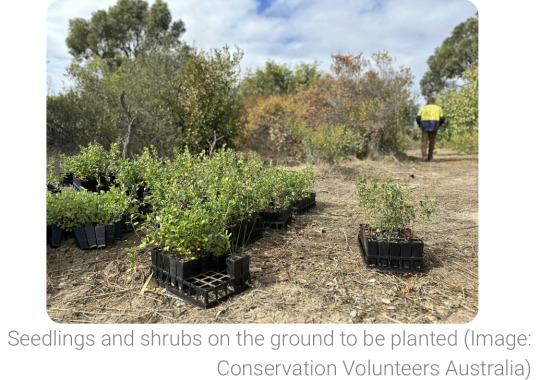
“A dedicated group of volunteers recently planted over a thousand native seedlings in Lewington Reserve [… and] re-established canopy cover to areas of the reserve to create cooling shade for the local community and provide homes for native wildlife. […] Planting lots of trees and shrubs in urban areas can help create shade and cool cities, mitigating the impacts of climate change, contributing to biodiversity conservation and building greener, more resilient communities.”
7. Sydney’s first dedicated affordable housing for trans women designed to deliver ‘positive outcomes’

“Community housing provider and charity Common Equity NSW, […] which is for people on very low to moderate incomes, prides itself on creating inclusive living and promotes the independence and well-being of people and communities […, and] will deliver the first-of-its-kind social housing in a bid to provide a safe place to live for transgender women seeking an affordable home.”
8. Rewilding: How a herd of bison reintroduced to Romania is helping ‘supercharge’ carbon removal

“170 European Bison reintroduced to Romania’s Țarcu mountains could help capture and store the carbon released by up to 84,000 average US petrol cars each year. […] By grazing a 48 square kilometre area of grassland in a wider landscape of 300 kilometres squared, they helped to capture an additional 54,000 tonnes of carbon each year. That is around 10 times the amount that would be captured by the ecosystem without the bison.”
9. World’s biggest grids could be powered by renewables, with little or no storage

“[…] 100% renewable supply can then match the load by putting surplus electricity into two kinds of distributed storage worth that [an energy expert] says are worth buying anyway – ice-storage air-conditioning and smart bidirectional charging of electric cars, and recover that energy when needed, filling the last gaps with unobtrusively flexible demand.”
10. Supporting the Long-Term Survival of Copper River Salmon and Alaska Native Traditions

“With $4.3 million in NOAA funds, the Copper River Watershed Project and The Eyak Corporation will remove fish passage barriers, opening more streams for salmon spawning and subsistence fishing. [… As part of this effort, o]ld narrow culverts that constrict water flow will be replaced with “stream simulation” culverts wide enough to fit the full stream, including its banks. They are also deep to allow contractors to place stones and other material inside to mimic a natural stream bottom.”
May 8-14 news here | (all credit for images and written material can be found at the source linked; I don’t claim credit for anything but curating.)
#hopepunk#good news#rhino#white rhino#africa#conservation#rewilding#climate change#florida#wildlife#life expectancy#health#spain#green space#urban parks#recycling#trees#global warming#trans#affordable housing#australia#bison#romania#carbon#carbon capture#renewableenergy#reforestation#salmon#alaska native#nature
390 notes
·
View notes
Note
all the round one polls are over!!! huzzah!!🥳🎉🎈🎂🍾
Hooray! Round 2 will be up on Monday.
Also, before anyone wonders. I've decided to take Gish and Cooper out of the bracket, because Birth of a Nation is an explicit hate film and Gish and Cooper's careers feel inseparable from it. I'll be replacing them with Fay Wray and Jennifer Jones as the women with the closest ties. For everything else, I'm sticking to the same rules I always stick to: it's up to you to research + decide if morality matters to your vote. I cannot adequately research every single candidate and every single issue, so removing these two is a rare move for me, and I hope this is the last time in this tournament I have to.
However, since this is an international bracket and I'm not aware of every woman's filmography, there may be other contestants here who took part in explicitly hateful propaganda films + showed no second thoughts about it (the second thoughts part is important). If you are aware of someone who took place in a film during our era that was made for the sole purpose of inciting violence and was as clearly and explicitly hateful in its intentions as Birth of a Nation, please send me a link to the film (if possible) and some backup material so I can review for myself and decide on a contestant's inclusion. If you can't provide the problematic film for me to see for myself or any conclusive evidence of the harm it directly caused, I will not remove a contestant; I don't operate on hearsay and I don't have time to do your research for you if you can't provide proof. If I see trolling about this, instead of honest discussion, I will block.
I spent a lot of time reading up on BoaN to make sure I made a decision I feel solid with, and my sources are under the cut.
Sources:
The Birth of a Nation: Media and Racial Hate by Desmond Ang
How a racist film helped the Ku Klux Klan grow for generations from the Economist
The Birth of a Nation: the most racist movie ever made from the Washington Post
The Legacies of Lillian Gish from Inside Higher Ed
Where to Begin with Lillian Gish from the BFI
Lillian Gish: should a great actor be judged by a racist film? from the Guardian
A Public Menace: how the fight to ban The Birth of a Nation shaped the nascent civil rights movement from Slate (this was my favorite of the articles and I think gives the best historical context for where BoaN came from, how it was made, and what its consequences were)
The movie itself, which I'm not linking. I watched enough of it to make up my mind, and it is its own best argument for being a film too intolerant to support in any measure. Hope everyone understands.
139 notes
·
View notes
Note
I would love to hear your opinions about ancient currency! And any recommendations you have for learning more about the Roman economy!
oh boy i am SO glad you asked! I'm going to put everything under a readmore because it's a Lot.
I have a few opinions on Greek coinage, specifically that of the introduction of coinage to Athens, though I'm working on a proposal for studying Spartan coinage rn.
Current publications re:Athens haven't really determined For Sure who introduced coins; it's a toss-up between Solon and Pisistratus but I'm in the Pisistratus camp for reasons that I can absolutely summarize in a separate post, as I've written and published a paper in my undergrad journal that (hopefully) holds weight in the current hodgepodge of thoughts. If you'd like that, I can write it up and link it here!
Re:Spartan coinage, I think the Spartan homoioi were real idiots. Most city-states were using silver (and very occasionally gold) for their coins, but Spartan homoioi were using iron spits. The spits (obeloi) were six to a drachma, which was the exchange rate for a long time. And by long time I mean there was no such thing as a floating conversion, coins were just the most portable form of precious metal, which was intrinsically valued. Outside Sparta (even the perioikoi) most city-states would have used ingots pre-coinage and that evolved into stamped metal, i.e. coinage. The Spartans considered themselves to be very religious and followed the Great Rhetra (unsure if Lykourgos existed), which maintained that silver and gold were holy and could not be used, so they used iron.
Unfortunately, the rest of Greece didn't follow that, and used silver in their coins, especially influenced by Attic-Ionian city-states who were in regular trade with Persia and further east, i.e. regions that valued precious metal outside their religious significance. Essentially, Spartans kinda screwed themselves over re:trade outside Sparta; they couldn't even trade in contemporary currency with the rest of Lakonia and forced their subject city-states into the same position. This is supported mostly by the explosion of Messenian and other Lakonian coinages after Sparta collapsed, though I want to see if I can find more text evidence, since I (an archaeologist) tend to rely too heavily on material. It's a whole thing, personally I believe this was a significant factor in Sparta's collapse, though other things factored in as well. Sparta was incredibly insular both in its trade/economy and religious practice and that combination led to its downfall.
For the Roman sources, I recommend starting with the Cambridge Companion to the Roman Economy by Walter Scheidel, and The Ancient Economy by Walter Scheidel and Sitta von Reden. Von Reden has excellent articles related to the ancient economy in general, and most are available on JSTOR, so I recommend giving her stuff a look.
I also highly recommend reading Moses Finley's work The Ancient Economy (no relation to Scheidel and Von Reden's work), as it lays the foundation for much of our current school of thought. Peter Temin's subsequent work, The Roman Market Economy argues against Finley and kicks off a whole debate about how to define an economy without using capitalism as the basis, because capitalism as we know and define it did not exist then, and it is incorrect to assume that. We can call it protocapitalist, but not capitalist.
Slavery in Rome is a nuanced subject that is integral to learning about its economy — I suggest keeping an open mind and treading carefully with respect to post-1492 slave trades. Noel Lenski's chapter "Framing the Question" (linked; you need access through your institution) discusses the slave trade against a Finleyan model, while Scheidel (him again) talks about how to determine the wages of slaves (JSTOR link). W. V. Harris talks about the demography and geography of slaves here (JSTOR link). These three are good starts for learning about Roman slavery, but if you want more sources, I can pull some up for you.
I don't want to overload you with sources, so in general I'll recommend anything by Scheidel, Von Reden, Nicholas Purcell and Peregrine Horden (connectivity), Seth Bernard (coins and emissions), Astrid Van Oyen (tech innovation), and Willem Jongman (economic structure). As with the slavery sources, if you want direct links I can definitely find them for you! I'm always happy to share info :)
70 notes
·
View notes
Note
Hi Lydia-Marc!
I want to reach out to you because of something you posted. Usually when I reach out like this, I get blocked, I’m hoping you’ll be willing to listen.
You said that “Zionism is a colonial movement that supports building an ethno-national state for Jewish people on top of Palestine, by any means necessary.” And then linked to Al Jazeera as proof.
I want to start by pointing out that Al Jazeera is the state media of Qatar, a nation that in its state approved textbooks teaches that the Protocols of the Elders of Zion (a debunked soviet antisemitic conspiracy theory) are true, as well as teaching that Jews are evil, and that the holocaust isn’t real/the holocaust was actually a Jewish plot to further their nefarious goals (https://efile.fara.gov/docs/3492-Informational-Materials-20200917-70.pdf). I am asking that you acknowledge that if that is what’s in state run textbooks, then the state media outlet might also be biased against Jews.
What you state Zionism is sound more like Kahanism (https://imeu.org/article/fact-sheet-meir-kahane-the-extremist-kahanist-movement ), a movement that most Jews (and most Jews – about 80-90% depending on the survey – are Zionist) thoroughly denounce. The founder and his political party were actually banned from participating in the Israeli government because most Jews found the movement so disgusting.
Zionism is actually a land back movement that supports self-determination for Jews in their ancestral homeland. (https://www.britannica.com/topic/Zionism ) A lot of leftists have decided to try to change the definition of the word into something more like what you said, but it’s a Jewish word to describe a Jewish movement, and non-Jews don’t get to define our words for us.
Applying a colonizer/colonized lens to the area is not really useful, but if you must, then please recognize that we have archeological evidence of Jews in the southern Levant going back over 3000 years (https://www.nytimes.com/2021/05/28/opinion/jewish-history-israel.html ), genetic evidence that even the whitest looking Ashkenazi Jews have middle eastern genetic markers (https://www.pnas.org/doi/full/10.1073/pnas.100115997 ), and written evidence from Rome talking about the Jews living in the area. In fact, we have maps showing that the area that is now called Palestine, used to be called Iudea (https://www.worldhistory.org/image/269/map-of-the-roman-empire-in-125-ce/ ) prior to Rome conquering the area, extracting its wealth, and taking the native, Jewish, population as slaves back to the empire (https://www.worldhistory.org/The_Bar-Kochba_Revolt/ , https://www.britannica.com/event/Siege-of-Jerusalem-70 ). The people who identify as Palestinian are the descendants of the people who filled the void left by Rome’s abduction of the Jews, and the descendants of the actual colonizers from the Arabian peninsula who showed up hundreds of years after the majority of Jews had already been evicted. The area has been colonized repeatedly, just not the way you claim.
I, personally, as a Zionist, am in favor of a two state solution, and I know many other Zionists that feel the same way. Palestinians have been living on the land a long time, and should have a state, but there is no denying that the area is the Jewish homeland, and they should be allowed a state of their own as well. It is frustrating to see so many people decide that self-determination (a human right!) is something that should be denied to the Jews, simply because they were conquered so long ago that everyone considers the colonizer’s presence to be “normal.” Apparently, somewhere along the line, Jewish indigeneity expired.
I hope you’re still reading this. I hope you’re willing to listen. If you have any questions, or want to discuss this further, I’m happy to talk.
Anyway,
43 notes
·
View notes
Note
You seem knowledgeable on the USSR, can you do a debunking of this post, or link me a source which debunks it?
https://www.tumblr.com/sanson-ki-mala-pe/746822120828502016/soviet-antisemitism-a-hundred-years-of-recycling
i don;t have time to address every claim made here, but it jumps out to me immediately that the source they're referencing, "More than a Century of Antisemitism: How Successive Occupants of the Kremlin Have Used Antisemitism to Spread Disinformation and Propaganda" is quite literally published by the US Department of State, and that this document in turn uses as one of it's major sources the Romanian defector Ion Mihai Pacepa, a controversial figure who's various claims have been frequently called into doubt even by those sympathetic to his cause.
for example, in this book review by the national catholic register [link], the author of the review, who is plainly sympathetic to Pacepa's anti-communist goals, nonetheless casts doubt on many of the claims he makes:
In the article “Moscow’s Assault on the Vatican,” published in 2007, Pacepa claimed he convinced legendary Vatican diplomat Msgr. Agostino Casaroli — later cardinal and secretary of state under Pope John Paul II — to let three Romanian agents, posing as priests, peruse the papal archives. Under scrutiny, Pacepa’s story began to unravel, with doubts expressed by historians and Vatican experts. Then the reason Pacepa claimed to have credibility with the Vatican collapsed: He said he had engineered a “spy trade” in 1959, exchanging jailed Romanian Archbishop Augustin Pacha for two spies caught in West Germany. But Archbishop Ioan Robu of Bucharest showed photos of the bishop’s 1954 crypt, explaining the heroic man was already dead when Pacepa claimed to have liberated him.
[...]
Vatican diplomats Cardinals Giovanni Cheli and Luigi Poggi were involved in negotiations with Romania and the Soviet bloc. Cardinal Cheli called Pacepa’s allegations “untruthful scenarios,” while Cardinal Poggi declared them “the product of a troubled mind and soul.” Archbishop Robu, who was consecrated by Cardinal Casaroli, emphatically calls the Pacepa account false: “We would know, it would be in our memories, if Romanian spies gained access to the Vatican Archives. It didn’t happen.”
[...]
In Disinformation, Pacepa credits KGB operations with everything from plotting the assassination of U.S. President John F. Kennedy to provoking the rise of Islamic extremism. In each scenario, he portrays himself as a witness to history — when his true rank and job description would never explain access to these events or decisions.
another similarly anti-communist catholic source is the catholic review, the official publication of the archdioces of baltimore. [link] they write:
Mr. Rychlak, the author of two books on Pope Pius and World War II, said he thinks Mr. Pacepa’s account needs to be verified in the Soviet archives. “Pacepa’s timing is questionable. Why hasn’t this story been revealed until now? I hope the United States government will declassify any information it has on this important matter, to spare the time a Freedom of Information Act request takes,” said Mr. Rychlak. John Cornwell, the British author of a 1999 book, “Hitler’s Pope: The Secret History of Pius XII,” told CNS he has never heard the claims described by Mr. Pacepa and considers them “most unlikely.” “As a supporter of NATO and the Western Alliance, it’s not inconceivable the pope could have been targeted (by the KGB). But I haven’t seen any credible documents indicating anyone doctored material,” said Mr. Cornwell, whose book was criticized by church officials for its negative portrayal of Pope Pius. Former colleagues of Mr. Pacepa, 79, expressed doubts about his story. “Between 1960 and 1962, when he pretends he ran Vatican spies, he was in Bucharest, assigned as a deputy in the techno-scientific section of Securitate (the Romanian secret police), where he stayed until he defected in 1978,” said a former high-ranking Securitate officer who would not allow his name to be used. “In the chain of command he would not have had direct communication with the KGB generals. If he did, that would make him a Soviet agent, not a Romanian one,” the source added. “In 1959, Pacepa was in Germany under diplomatic cover. He was a captain in Cologne with a degree in chemistry and belonged to the techno-scientific section. Again, the KGB generals wouldn’t have taken him into consideration,” said the source, who believes Mr. Pacepa is trying to build a “mysterious aura” for himself in his later years. “Why did he wait 29 years (since his defection) to reveal this? If it’s true, it would have made so much sense to put it on the table in 1981, after the Soviet-Bulgarian plot to assassinate Pope John Paul II,” the source said. A former Romanian diplomat of the communist era, who has advised the U.S. government, expressed “deep doubts” about the account. “Pacepa is not a serious source,” said the former diplomat. “His book ‘Red Horizons’ (1988) is about one-third fiction. He takes some real facts, and then invents. “I’m afraid he is just trying to bring attention to his persona. He invokes the Vatican because the Romanian Securitate has been exhausted and is a marginal issue,” he added. “Pacepa does not document. Given the gravity of the affirmations he makes, in order to be credible, he must unveil the source, himself, or otherwise it is fiction,” said the retired diplomat.
given Ion Mihai Pacepa's overall track record, i would certainly like to see some other source verifying the various claims that the "More Than A Century Of Antisemitism" cites from him, most especially the claim that the USSR distributed copies of the Protocols in arabic in the middle east, a claim I cannot find any other source for.
Edit: also i should note that one of the major thrusts of the "More Than A Century Of Antisemitism" document is to smear all criticism of Azov in Ukraine as somehow antisemitic, which is just ludicrous. regardless of how you feel about the war in Ukraine, there are legitimate criticisms to be made of Azov Battalion and the role they have played there.
32 notes
·
View notes
Text
introduction / pinned post.
Howdy - I'm Maddie, but you can call me Minerva, minervamagicka or any of the three. I've been playing the Sims since 2010 and making CC for just about as long; though my current focus is Sims 4 equestrian-themed content in collaboration with my partner in crime, Schrodcat, who you can find on DA. Both of us will have a hand in just about everything that is to be released on this tumblr & to DA.
cc master folders
I've reorganized my SFS into folders that I'll be linking below for folks to refer to when searching for my CC. If you'd rather get everything in one go, this is the easiest way to do it!
Click here to view the SFS folder for all of my SIMS 3 content.
Click here to view the SFS folder for all of my SIMS 4 content.
These folders (or, well, just the TS4 folder) will have all of my CC added to them as its' released so they'll always be up to date!
p.s. if any creators would like an SFS code please message me!
donations
I'm not going to proselytize too much concerning my stance on modding and financial compensation here, as it could be an essay in and of itself. What it comes down to is this; everything I ever post for download will always be and always shall be 100% free. It will never be paywalled, hosted behind an ad.fly link or for purchase. However, for those who may want to buy me a coffee so I can fuel my caffeine addiction and keep posting at the speed of sound;
My Ko-Fi & SchrodCat's Ko-Fi / SchrodCat's Patreon
Again; financially supporting one, either or both of us will not grant access to anything exclusive or tangible beyond our gratitude. Additionally, donating with suggestions or requests will not mean those ideas will be automatically fulfilled as if they were a commission. This is just if you wish to express some thanks and get us some drinks!
requests / 'can you do xyz?'
I'm always happy to receive any requests or suggestions for what to release next, however me & S already have quite the list of personal ideas we want to get through first. Therefore, any requests we get will be secondary to those until we finish.
'what are you working on right now?'
S & I have set up a proper Trello board to track our progress on our original meshes & game conversions. You can view it here!
'how can i learn to mod?'
My friend Schrodcat wrote an excellent DA post on this topic with links to resources & some very solid advice on getting into CC creation or modding in general.
'you didn't make [xyz game model], how dare you convert it to the sims?!'
As I've seen an uptick in off-site concern over my [Game]toTS4 conversions, I'm adding this disclaimer to my pinned post that I do not convert models for profit, and I do so transformatively and as a fan of the original work. If it continues to bother you that I do so without the explicit permission/support of the games I port from, I kindly ask you to not engage and to leave my blog.
To learn more, I recommend reading my initial statement on my SSO ports, or, if you're interested in learning more about my stance on modding and my belief in the 'moral economy' of modding in general, this published journal covering the subject may of interest, or this journal article explicitly discussing the use of copyrighted material in modding.
🎊 latest release
→ [MMxSC] Loose Ring Snaffle Bridle
66 notes
·
View notes
Text
RECENT SEO & MARKETING NEWS FOR ECOMMERCE, JULY 2024
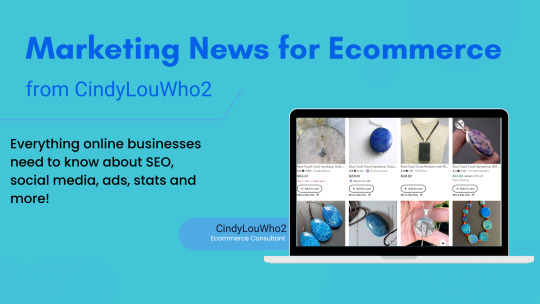
If you are new to my Tumblr, I usually do these summaries of SEO and marketing news once a month, picking out the pieces that are most likely to be useful to small and micro-businesses.
You can get notified of these updates plus my website blog posts via email: http://bit.ly/CindyLouWho2Blog or get all of the most timely updates plus exclusive content by supporting my Patreon: patreon.com/CindyLouWho2
TOP NEWS & ARTICLES
There is a relatively new way to file copyright claims against US residents, called The Copyright Claims Board (CCB). I wrote more here [post by me on Patreon]
After a few years of handwringing and false starts, Google is abandoning plans to block third-party cookies in Chrome. Both Safari and Firefox already block them.
When composing titles and text where other keywords are found, it can be useful to have a short checklist of the types of keywords you need, as this screenshot demonstrates. While that title is too long for most platforms and search engines, it covers really critical points that should get mentioned in the product description and keyword fields/tags as well:
The core keywords that describe the item
What the customer is looking to do - solve a problem? Find a gift? Feel better?
What makes the product stand out in its field - why buy this instead of something else? Differentiating your items is something that should come before you get to the listing stage, so the keywords should already be in your head.
Relevant keywords that will be used in long tail searches are always great add-ons.
What if anything about your item is trendy now? E.g., sustainability? Particular colours, styles or materials/ingredients are always important.
SEO: GOOGLE & OTHER SEARCH ENGINES
Google’s June spam update has finished rolling out. And here is the full list of Google news from June.
Expect a new Google core update “in the coming weeks” (as if we needed more Google excitement).
Google’s AI overviews continue to dwindle at the top of search results, now only appearing in 7% of searches.
Despite Google trying to target AI spam, many poorly-copied articles still outrank the originals in Google search results.
Internal links are important for Google SEO. While this article covers blogging in particular, most of the tips apply to any standalone website. Google also recently did a video [YouTube] on the same topic.
Google had a really excellent second quarter, mostly due to the cloud and AI.
Not Google
OpenAI is testing SearchGPT with a small number of subscribers. Alphabet shares dropped 3% after the announcement.
SOCIAL MEDIA - All Aspects, By Site
General
New social media alert: noplace is a new app billed as MySpace for Gen Z that also has some similarities with Twitter (e.g., text-based chats, with no photos or videos at this time). iOS only at the moment; no Android app or web page.
Thinking of trying out Bluesky? Here are some tips to get the most out of it.
Facebook (includes relevant general news from Meta)
Meta’s attempt at circumventing EU privacy regulations through paid subscriptions is illegal under the Digital Markets Act, according to the European Commission. “if the company cannot reach an agreement with regulators before March 2025, the Commission has the power to levy fines of up to 10 percent of the company’s global turnover.”
If you post Reels from a business page, you may be able to let Meta use AI to do A/B testing on the captions and other portions shown. I personally would not do this unless I could see what options they were choosing, since AI is often not as good as it thinks it is.
Apple’s 30% fee on in-app ad purchases for Facebook and Instagram has kicked in worldwide as of July 1.
Facebook is testing ads in the Notifications list on the app.
Meta is encouraging advertisers to connect their Google Analytics accounts to Meta Ads, claiming “integration could improve campaign performance, citing a 22% conversion increase.”
Instagram
The head of Instagram is still emphasizing that the number of DM shares per post is a huge ranking factor.
LinkedIn
Another article on the basics of setting up LinkedIn and getting found through it.
You can now advertise your LinkedIn newsletters on the platform.
Pinterest
Pinterest is slowly testing an AI program that edits the background of product photography without changing the product.
Is Pinterest dying? An investment research firm thinks so.
Reddit
If you want to see results from Reddit in your search engine results, Google is the only place that can happen now.
More than ever, Reddit is being touted as a way to be found (especially in Google search), but you do have to understand how the site works to be successful at it.
Snapchat
Snapchat+ now has 9 million paying users, and they are getting quite a few new personalization updates, and Snaps that last 50 seconds or less.
Threads
Threads has hit 175 million active users each month, up from 130 million in February.
TikTok
TikTok has made it easier to reuse your videos outside of the site without a watermark.
TikTok users can now select a custom thumbnail image for videos, either a frame from the clip itself, or a still image from elsewhere.
Twitter
You can opt out of Twitter using your posts as data for its AI, Grok.
YouTube
YouTube has new tools for Shorts, including one that makes your longer videos into Shorts.
Community Spaces are the latest YouTube test to try to get more fan involvement, while moving users away from video comments.
(CONTENT) MARKETING (includes blogging, emails, and strategies)
Start your content marketing plans for August now, including back-to-school themes and Alfred Hitchcock’s birthday on August 13.
ONLINE ADVERTISING (EXCEPT INDIVIDUAL SOCIAL MEDIA AND ECOMMERCE SITES)
Google Ads now have several new updates, including blocking misspellings.
Google’s new Merchant Center Next will soon be available for all users, if they haven’t already been invited. Supplemental feeds are now (or soon will be) allowed there.
STATS, DATA, TRACKING
Google Search Console users can now add their shipping and return info to Google search through the Console itself. This is useful for sites that do not pay for Google Ads or use Google’s free shopping ads.
BUSINESS & CONSUMER TRENDS, STATS & REPORTS; SOCIOLOGY & PSYCHOLOGY, CUSTOMER SERVICE
The second part of this Whiteboard Friday [video with transcript] discusses how consumer behaviour is changing during tight economic times. “People are still spending. They just want the most for their money. Also, the consideration phase is much more complex and longer.” The remainder of the piece discusses how to approach your target market during these times.
Prime Day was supposedly the best ever for Amazon, but they didn’t release any numbers. Adobe Analytics tracked US ecommerce sales on those days and provides some insight. “Buy-now, pay-later accounted for 7.6% of all orders, a 16.4% year-over-year increase.”
MISCELLANEOUS
You know how I always tell small business owners to have multiple revenue streams? Tech needs to have multiple providers and backups as well, as the recent CrowdStrike and Microsoft issues demonstrate.
If you used Google’s old URL shortener anywhere, those links will no longer redirect as of August 25 2024.
15 notes
·
View notes
Text
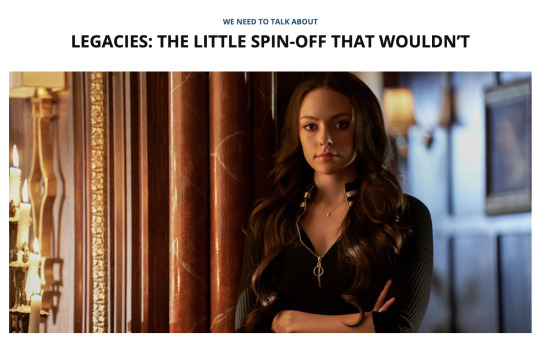
Legacies: The Little Spin-Off That Wouldn't
[Article translated into English below; access link above for original Portuguese version.]
With the first anniversary of Legacies' series finale long past us, it seems the appropriate time has finally come for us to reflect a bit on the various elements that led to the series not achieving the same kind of success as its predecessors. If you haven't seen this spin-off of The Vampire Diaries and The Originals in its entirety, don't worry; you didn't miss out on much. If, on the other hand, you followed the series and our reviews while it was on the air, you know we have a lot to discuss. So grab your favorite snacks, maybe a drink, and without further ado, let's get into it.
Created by Julie Plec, Legacies premiered in October 2018 on The CW. The spin-off provides a continuation to the story of Hope Mikaelson (played by Danielle Rose Russell since The Originals' fifth season), the descendant of some of the most powerful lineages of vampires, witches, and werewolves in the universe created by The Vampire Diaries. The teenager attends the Salvatore School for the Young and Gifted, a boarding school that aims to provide a safe haven for young supernatural beings, teaching them to control their powers and navigate the challenges of an adolescence which, albeit similar to that of ordinary mortals, isn't without its differences.
Despite a promising premise that had indeed worked in the past, Legacies came to an end after only four seasons, becoming one of the last series to succumb to the great purge of 2022. This cancellation was not received with much surprise by most of its audience, who, after a season marked by the departure of an original cast member, anticipated the inevitable. However, Legacies' failure can hardly be exclusively attributed to what happened during its final stretch, having the problems of "the little spin-off that wouldn't" started long before the final nail was ever hammered into its coffin.
The Forgotten Legacy
As a spin-off, Legacies inherited not only a well-established vast universe from its predecessors but also the obligation to find its own voice within it. It's quite the burden, but let's be honest: anyone who wanted to revisit The Vampire Diaries or The Originals could do so at any time, so something a little different wouldn't have been frowned upon. However, while there is much to be said about Legacies' distinct tone – and, believe me, we will get to it –, one of its cardinal sins will forever be the relationship of narrative neglect it maintained to the original series.
For a self-titled "legacies" show, Legacies always used its source material rather loosely, treating the inherited mythology and characters with carelessness. If its solid mythological foundation was disrespected and scattered with the introduction of the ill-fated "monster of the week," so were the very characters who were brought into this derivative of The Vampire Diaries. By name alone, Hope, Josie (Kaylee Bryant), and Lizzie (Jenny Boyd) are the "legacies" the series should've served. Instead, the baggage they had accumulated throughout both original series and its implications were often minimized to favor a more carefree plot, reducing the main trio to a mere shadow of what it could've been.
It's purely antithetical that Legacies sought to capitalize on the emotional connection its audience had to the source material all the while ignoring it entirely, but that didn't stop it from trying. This led to the existence of cameos and references that, in an attempt to evoke a nostalgic feeling, appeared at moments that contributed little to the plot. If, in The Originals, Hope's family moved heaven and earth for the young tribrid, in Legacies, they seemed too busy to provide any kind of support to the character until the ratings demanded it. As for Caroline's (Josie and Lizzie's mother, portrayed by Candice Accola) absence, although its reason was briefly explained at the beginning of the season, her mission hardly justified her being gone through circumstances that truly warranted her visit, with the character making her first and only appearance in Legacies' series finale.
Everything Everywhere All at Once
As previously mentioned, it's no secret that Legacies attempted to differentiate itself from the other series in its universe by adopting a lighter tone, opting for largely inconsequential narratives, caricatured villains, and a whole roster of stock characters. During its first season, this gave the show its own vibe, something akin to series like Legends of Tomorrow: a comic book series with a somewhat out-there premise, but still with rather captivating characters. However, Legacies quickly began to alternate between its decidedly camp style and a more serious tone in an attempt to rationalize its overall lack of seriousness. Thus, while one episode would present a more grounded reality, the next would return to its extravagant origins, giving rise to scenarios such as a musical, a dream world, and even an alternate universe.
This inconsistency in tone between episodes had a negative impact on the various storylines and how they were received. The constant change not only left the series' audience uncertain about what to expect from any given episode but also caused many important storylines to fall flat, their content and message often contrasting with the overall tone of that particular chapter.
It's fair to say Legacies tried to be a bit of everything: comedy, drama, fantasy, film noir, western – the list goes on. But thinking that this amalgamation of genres would result in a cohesive series was just another of the many mistakes made by the production. Continuing on this topic, whose inevitable conclusion is the maxim "less is more," Legacies was inconsistent even with its characters, introducing a too vast array of figures that, ultimately, it couldn't develop. Instead of focusing on the main and secondary characters it introduced during its first season, the series wasted its time not only with the monsters that appeared in each new episode, but also with so many figures whose impact on the narrative proved negligible. Eventually, this disregard was reflected in the loss of actors (such as Olivia Liang or Peyton Alex Smith) and characters of interest to the audience to more appealing projects.
A Wronged Protagonist
Werewolf, vampire, witch. These are the three factions from which Hope Mikaelson descends, making her the first tribrid in the The Vampire Diaries universe and one of the most powerful supernatural beings in its mythology. When dealing with characters as overpowered as Hope, there are several avenues writers can explore to lay the foundation for their conflict. They can create an even greater force to pose a challenge to the protagonist, or they can choose to present an internal struggle, for example. Ideally, good writers seek to develop both external and internal conflicts side by side. Legacies, however, relegated all of Hope's baggage to the background, neglecting all that made the character great in favor of a supernatural bulldozer that had little use beyond dealing with whatever threat was present at the time.
The primary conflict for a character like Hope Mikaelson should always be internal – that's a fact. In this particular case, Legacies had no shortage of material to work with, to the extent that it would be possible to write an entire article about its protagonist alone. Identity crises due to her unique position in the supernatural world, expectations associated with her lineage, the fear of becoming like her parents, ethical and moral issues related to her powers, the fear of losing those around her... These are just some of the many viable options the series had at its disposal but, unfortunately, chose not to explore.
Another criticism that must be leveled at how Legacies treated its protagonist related to the romantic relationship between the character and Landon Kirby (played by Aria Shaghasemi). For reasons that, in all honesty, I'm still unable to comprehend, higher powers believed it would be beneficial for the series to focus its narrative on Landon instead of Hope. Thus, storylines like that of Malivore – which initiated the external conflict of Legacies – gradually began to shift toward the character, placing Hope in a secondary position.
Finally, the very characterization of the protagonist suffered from the presence of Landon in her orbit. Any qualities or interests the young Mikaelson might've had faded over time. In a way (and taking the opportunity to make a Barbie reference), he was everything; she was just Hope.
The Risks Not Taken
The existence of a protagonist like Hope, all-powerful and always ready to save the day, was a factor that consistently contributed to the lack of perceived stakes throughout the series. Legacies had several other opportunities to raise the bar of its storyline but, like many other aspects discussed throughout this article, it chose the easiest path to tread. In general, whenever something a bit more daring happened, it quickly got resolved. This rule could be applied to almost everything within the show, from narrative threads that were concluded easily and inconsequentially to the deaths and subsequent resurrections of a handful of characters.
Combined with the fact that the narrative was almost circular in both its content and development, this regression in any kind of weighty decision resulted in a progressive loss of interest for an audience that, considering the unpredictability of The Vampire Diaries and The Originals, concluded that the spin-off was entirely too mild.
In summary, the series made promises it simply couldn't keep. Its initial marketing and the premise set forth during its first season had little to do with what the spin-off eventually became. Instead of a drama about the trials and tribulations of supernatural teenagers with a special focus on a trio of female lead characters, the audience ended up with a clash of titans between these same young adults and Greco-Roman gods. No, I don't think it's unreasonable to say that the production of Legacies lost the plot.
Even with months separating the end of the series and the date I finish writing this article, it's impossible not to feel a certain level of frustration with this spin-off. Legacies had everything it needed to become a successful series, including feedback from the audience and numerous opportunities over time to correct its many mistakes, but it never did. Whether out of pride or stubbornness, it continued to dig its own grave by reinforcing everything its fans and critics complained about. For this reason, Legacies will forever live in my memory not as "the little spin-off that could" (an allusion to the folktale The Little Engine That Could), but rather as "the little spin-off that wouldn't."
You can revisit Legacies on Max.
49 notes
·
View notes
Note
Hi, so I came across your post about the PR relationship not being helpful to Austin Butler in anyway and I see this argument a lot. Its mostly from people who think they are real and want to prove that he gets nothing out of agreeing to be with her. They always toss out that he was nominated for an Oscar, won a bafta and a golden globe. It is their biggest thing to point out the fame he has *now*.
What so many seem to fail to realize, and I would like to open it up for discussion between us, is that he was first linked to her at the premier of the Elvis movie, meaning long before he was ever this famous. His contract started with her long before he was this award winning actor that was being talked about for his performance. Meaning that at the time that he entered the contract she was *technically* the more famous of the two. She could get him brand deals, and with her family connections could get him through doors he didn't have access to before. She could help further his career. But then Elvis took off and made him pretty much a list material and she was no longer needed.
She no longer served a purpose with his career and he was making connections all on his own without her anywhere in sight so it turned to giving her exposure and keeping him in the headlines no matter what. So now we get pointless pap shots, him reading her book club book to promote it, going to her fashion show to be supportive but he's also a face of the brand so would have been invited anyway. And since she has no big events that he can gain anything from we get dumb shots of them on vacation with her family to show how close they are. All which helps her and gives him nothing other than staying in the headlines... or so it would seem.
For those who will scream that the ride of Elvis is over he can end the contract... The strikes hit pretty rapidly after award season. Plus he is looking to produce a new movie, has a few coming out in the next few months. With the strikes in place he can't promote any of that... But all the articles that come out about him mention those projects reminding people that not only are they "together" but that dune is coming out, bikeriders is coming out, he's producing. The contract still serves a purpose for him and his career. I think long as the strikes go and he can't do self promotion for anything he will continue to be with Kaia.
Once the strikes ends and he doesn't need the relationship to keep his project names out there then it will end. At least this is what I think. I leave the floor open to you and any others that want to discuss this further.
LOVE your observation!! Sorry the late reply.
To answer in short: even if they were together BEFORE his career took off, it’s because normally you can see where things are going. Meaning they knew Elvis was going to take off!! So no, she actually came at the right time someone uses someone. It then because about EXTENDING the contract.
Austin is simply just uncomfortable around her and always indicated so. So I’m glad they’re over xx
3 notes
·
View notes
Text
Good News - April 15-21
(Sorry it's late, I got sick)
Like these weekly compilations? Support me on Ko-fi! Also, if you tip me on here or Ko-fi, at the end of the month I'll send you a link to all of the articles I found but didn't use each week - almost double the content! (I'm new to taking tips on here; if it doesn't show me your username or if you have DM's turned off, please send me a screenshot of your payment)
1. Restoring an unsung hero

“"We are aiming to restore a significant area of seagrass around Nova Scotia, rebuilding these ecosystems and doing it in a climate-smart way," says Derek Tittensor, head of the FOME research group and a professor of biology at Dalhousie. "Importantly, we are also integrating Indigenous and scientific knowledge of these remarkable ecosystems through a two-eyed seeing approach.””
2. Four super-rare quolls caught sneaking around Australian wildlife sanctuary

““We had a mysterious case of cat-trap tampering whereby the traps were closed, the bait was gone but no culprit inside,” explains AWC Field Ecologist, Erin Barritt. [… T]he opportunistic little mischief-makers were juvenile western quolls, the first to be born on the sanctuary in 100 years.”
3. LGBTQ+ parents are raving about ‘accessible’ gender-neutral children’s book What Makes A Baby
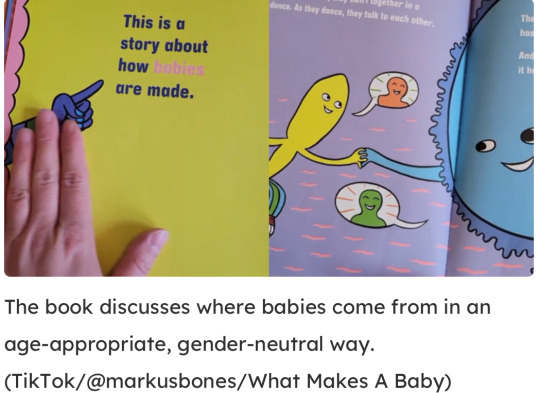
““Overall I think this is a great book and a great representation of what inclusive media can look like. It incorporates a variety of perspectives and experiences to make something that is accessible to everyone.” The LGBTQ+ community – with parents in particular – praised “the accuracy of the terminology”, with one writing: “Human anatomy isn’t too much for children to learn and this book makes it so accessible for them to learn!””
4. Switch to green wastewater infrastructure could reduce emissions and provide huge savings according to new research
“Researchers have shown that a transition to green wastewater-treatment approaches in the U.S. that leverages the potential of carbon-financing could save a staggering $15.6 billion and just under 30 million tons of CO2-equivalent emissions over 40 years.”
5. Millions Offered Up To Create New Disability Employment Models

“[Projects] can focus on increasing access to advanced technology careers, using advanced technology to support youth or adults with disabilities to access competitive integrated employment or helping justice-involved youth with disabilities gain employment. In addition, projects can look at early intervention and workforce reintegration strategies for those with acquired disabilities or efforts to reintegrate disconnected individuals with disabilities into the workforce.”
6. Laser-Treated Cork Absorbs Oil for Carbon-Neutral Ocean Cleanup
“Cork comes from the bark of cork oak trees, which can live for hundreds of years. These trees can be harvested about every seven years, making cork a renewable material. When the bark is removed, the trees amplify their biological activity to replace it and increase their carbon storage, so harvesting cork helps mitigate carbon emissions.”
7. This boat runs on 100% renewables. Can it help clean up bigger ships?

“For the past seven years, Energy Observer has traveled around the world, serving as a floating test bed for zero-emission technologies that can propel boats and ships — without spewing any of the nasty pollution that comes from running diesel engines. […] The project’s leaders say they’re now ready to focus their efforts on cleaning up much larger and dirtier types of vessels, including cargo ships.”
8. 1,000 oceanic manta rays seen in the Maldives
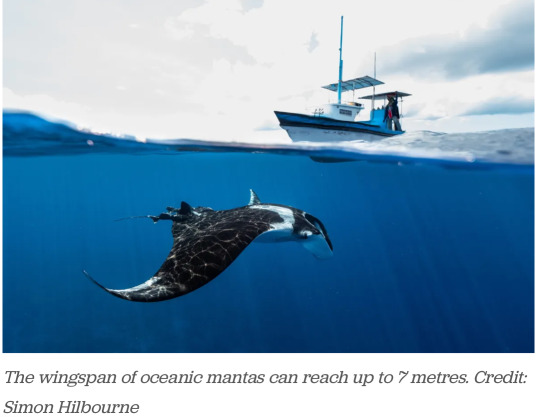
“With 1,000 individuals in its waters, the Maldives is home to the world’s third largest population of giant mantas (it also has the most reef mantas (Mobula alfredi) in the world, with over 5,000 individuals).”
9. Service Finalizes Land Protection Plan for Expanding Muleshoe National Wildlife Refuge

“Plan aims to deliver in-perpetuity conservation of up to 700,000 acres of land for benefit of migratory and resident wildlife. […] "These vast grassland landscapes provide essential habitat for wildlife while also providing benefits like clean water filtration and carbon sequestration, which are essential for both the environment and human well-being."”
10. Medicaid Officials Remove Barriers For Those With Disabilities

“In addition [to grace periods for submitting paperwork], states will no longer be allowed to conduct renewals any more than once every 12 months and they will be barred from requiring in-person interviews for people with disabilities, among other changes.”
And a bonus article to make up for posting late: Gay Furry Hackers strike again!
April 8-14 news here | (all credit for images and written material can be found at the source linked; I don’t claim credit for anything but curating.)
#hopepunk#good news#nature#ocean#climate#climate change#canada#australia#wildlife#lgbtq#lgbtqia#book#disability#employment#rehabilitation#disabled#accessibility#carbon#oil spill#cork#boat#renewableenergy#renewablefuture#solar energy#manta ray#fish and wildlife#birds#habitat#conservation#medicaid
14 notes
·
View notes
Text
Distributed Denial of Secrets — the nonprofit transparency collective that hosts an ever-growing public library of leaked and hacked datasets for journalists and researchers to investigate — has been a major source of news for organizations like the New York Times, the Washington Post, the Wall Street Journal, The Guardian, BBC News, Al Jazeera, the Associated Press, Reuters, and Fox News, among others. It has published datasets that shed light on law enforcement fusion centers spying on Black Lives Matter activists, revealed Oath Keepers supporters among law enforcement and elected officials, and exposed thousands of videos from January 6 rioters, including many that were used as evidence in Donald Trump’s second impeachment inquiry. (Disclosure: I’m an adviser to DDoSecrets.) But not everyone is a fan. DDoSecrets has powerful enemies and has found itself censored by some of the world’s biggest tech companies, including X (formerly Twitter) and Reddit. The governments of Russia and Indonesia are also censoring access to its website. Shortly before the 2020 election, Twitter prevented users from posting links to a New York Post article based on documents stolen from Hunter Biden’s laptop, citing a violation of the company’s hacked materials policy. After intense pressure from Republicans, Twitter reversed course two days later. This was widely covered in the media and even led to congressional hearings. What’s less well known is that earlier in 2020, in the midst of the Black Lives Matter uprising, Twitter used the same hacked materials policy to not only permanently ban the @DDoSecrets account, but also prevent users from posting any links to ddosecrets.com. This was in response to the collective publishing the BlueLeaks dataset, a collection of 270GB of documents from over 200 law enforcement agencies. (German authorities also seized a DDoSecrets server after the release of BlueLeaks, bringing the collective’s data server temporarily offline.) When Elon Musk bought Twitter, which he has since renamed X, he promised that he would restore “free speech” to the platform. But Musk’s company is still censoring DDoSecrets; links to the website have been blocked on the platform for over three years. Lorax Horne, an editor at DDoSecrets, told The Intercept that they are “not surprised” that Musk isn’t interested in ending the censorship. “We afflict the comfortable, and we include a lot of trans people,” they said. “Transparency is not comforting to the richest people in the world.” [keep reading]
23 notes
·
View notes
Text
The system red states are constructing works by empowering extreme ideologues and partisans to impose their will on their communities, whatever level of popular support they happen to enjoy. Dissenters get the right to set public health and educational policy, overriding the judgment of elected school boards and expert regulators. Anti-abortion vigilantes and anti-LGBTQ+ extremists are empowered to surveil their neighbors and rewarded for bringing legal proceedings against them. Lax open-carry laws, immunity from criminal prosecution, promises of kid-glove treatment from police and prosecutors, and pardons when “leftist” prosecutors try to crack down on right-wing thuggery signal to militias and other reactionary radicals that they can engage in political violence with near impunity.
Examples abound. This year, Indiana’s Republican attorney general, Todd Rokita, launched a website with the Orwellian name “Eyes on Education.” The website invites informants to report on teachers who share “objectionable curricula, policies, or programs”; it also posts personally identifying information that can easily be used to dox or harass educators. Among the “objectionable” materials reported through the site is an email from a superintendent who vowed to “address societal injustice in our classrooms” in the aftermath of George Floyd’s murder. After Florida enacted its Safety in Private Spaces Act, banning transgender people from using state-owned bathrooms that match their gender identity, transgender and cisgender residents alike have reported being assaulted by bystanders claiming that they “don’t belong” in public restrooms. Localordinances designed by Jonathan Mitchell, the lawyer behind Texas’ anti-abortion bounty-hunter scheme, use vigilantes to target individuals who cross state lines to secure abortions. Georgia is implementing changes to its electoral rules that practically invite hardcore partisans to disrupt the certification of election results, a strategy with origins in the 2000 presidential election that MAGA leaders returned to in 2020 and 2022.
. . .
one of the most widely reported proposals in Project 2025 is its threatened “campaign to enforce the criminal prohibitions” of the Comstock Act “against providers and distributors of abortion pills.” That law, enacted in 1873 amid a sexual-purity crusade, purports to make it illegal to mail any “article or thing … intended for producing abortion.” For decades, federal agencies under both Republican and Democratic administrations interpreted the Comstock Act narrowly, to apply only when the person mailing an article or thing intended that it be used unlawfully. Reversing this long-standing position would trigger not only a wave of federal criminal prosecutions, as speakers at the Democratic National Convention stressed. It would also kick off a surge of vigilante lawsuits under local laws that authorize ordinary citizens to enforce federal abortion restrictions.
More at the link.
3 notes
·
View notes
Note
Hello! I have a question about evaluating and understanding scientific sources. You seem to be interested in that sort of stuff, so I figured I'd pop over and ask. Feel free to answer or not answer, whatever you wish.
What is the difference between a scientific study, a review, a meta-analysis, and a commentary? I am asking because I am confused on how to interpret some reading I looked into while researching on gender identity and sexuality.
This commentary states that, "No evidence has shown gender identity to be innate." A paragraph in the commentary goes on to say that, "Much has been made of differences in brain structure and activation between transgender and cisgender people, but the significance of that work is unclear. Differences are found in regions with no obvious ties to gender identity. There is little work on the neural substrate of gender identity itself, and it is unclear how cortical thickness, white matter microstructure, or activation to various stimuli have conceptual relevance for gender identity. But, even if such differences are better understood, they do not necessarily reflect predetermined or innate behaviour. The brain is plastic, and changes in response to behaviour and environmental input. Brain differences between transgender and cisgender people may simply reflect (or result from) their behavioural differences and not mark a cause of their gender identity."
I am a bit confused on how to understand this information, because the commentary doesn't cite any specific work in this paragraph that I can compare it to. Why do numerous studies discuss differences in the brain affecting gender identity itself if the differences "do not necessarily reflect predetermined or innate behavior?" I think I am missing a piece of the puzzle here in understanding the material.
I just realized I technically asked more than one question, but I gave the example because it's what got me confused on interpreting this information and relating it to other information, as well as on what exactly a commentary is. Thank you for reading over this post.
From what I understand, a meta-analysis is a systematic review that draws from multiple studies, instead of just citing one specific one. Commentaries can depend, because they can either be judging a source by the quality of its arguments, or simply be an author giving their own subjective opinion on a matter that isn't meant to be taken as strictly scientific. Sometimes it's both.
The commentary you cited seems to be mostly the former, with it criticizing the validity of the arguments made by people who support the idea of gender identity being innate. It could absolutely be influenced by unconscious biases that the author holds, but that can go for people in support of innate gender identity too. It's easy to say "there's no proof of gender being innate", when it's just human nature to seek out sources that confirm our own preconceived notions about how the world works (confirmation bias). Same goes for people trying to prove the inverse.
So in short: the commentary is just that. Someone commenting on a study or a multitude of studies pertaining to their own field of expertise, and criticizing the validity of those studies in relation to what they were trying to claim. I do think we have a long way to go in understanding the human brain myself, even if I do lean heavily towards neurological sex being a real thing. Doesn't mean scientists and random people won't keep trying to debate whether it truly exists or not, though. It's kind of in a weird spot right now.
Link that further explains what a commentary is:
2 notes
·
View notes
Text
Orientalism is the manner of seeing that visualizes, overstates, accentuates, and distorts dissimilarities of the Arab peoples and cultures as weighed against those of the United States and Europe. Further, orientalism involves studying the cultures and societies, people, and languages of the near and Far Eastern by Western Scholars who see the Arabic culture as backward, uncivilized, exotic, and occasionally risky. However, perception of the East arises from preconceived archetypes envisioning all of them as similar to each other but essentially variant from the Western societies without any supporting facts or reality. Said in his criticism of orientalism redefined it as the constellation of false assumptions that underlay the attitude of the Western nations towards the Middle East. The Western nations, America and European thereby used orientalism culture and romanticized images of Middle East and Asia as a justification of their colonial and imperial ambitions. Said fiercely denounces this culture and equally criticizes the Arab elites whose practices revolved around internalized ideas from British and American orientalists. The danger linked to the orientalism culture by the West is that some East can treat it as truth thereby affecting relations and ideologies. However, Said emphasizes that it is hard to label half of the continent as orient and manage to generalize that what applies to Egyptians equally applies to Chinese. Orientalism in this paper supports Edward Said’s critical theory approach to international relations theory where the West forms a one-way image of the Oriental. The discussion focuses on definition of terms, orientalism and Occident, and early orientalism and contemporary orientalism. Definition of terms The orient according to Said refers to a representations’ system enclosed by forces from politics that introduced the orient into western consciousness, Western learning, and Western Empire. The system of representation results from the condensation of diverse attributes into a single image not from facts but from perceptions that are regarded as a standard of comparison. In addition, orientatlism offers a criterion for evaluation that other world societies rank negatively or positively thereby functioning as an ideology. For the West, the orient is constructed relative to the West and has largely assisted in the definition of Europe or the West since it is views as the contrasting image, experience, idea, and personality. The orient involves nations adjacent to Europe and that form the greatest, oldest, and richest colonies. In addition, the Orient is also the best resource for language and civilization, cultural contenders, and one of the innermost and recurring images of the other. Additionally, the orient orient assisted in definition of the modern day Europe, part of its European material culture and civilization Read the full article
0 notes
Text
The Timeless Strength of Concrete Posts in Fencing
Introduction to Durable Fencing Solutions
When it comes to creating a sturdy, long-lasting boundary for your property, few materials can rival the resilience and versatility of concrete posts. These robust structures have been a staple in fencing for decades, offering homeowners, farmers, and businesses a reliable way to secure their land. Paired with the expertise of a trusted fencing supplier, concrete posts provide an unbeatable combination of strength and practicality. In this article, we’ll explore why these posts have stood the test of time, how they enhance modern fencing systems, and what makes them a top choice for anyone looking to invest in a durable perimeter.
Fencing is more than just a functional necessity; it’s a statement of security and style. Whether you’re enclosing a garden, protecting livestock, or marking the boundaries of a commercial property, the materials you choose matter. Concrete posts bring a unique blend of durability and adaptability, making them a go-to option for those who value quality over fleeting trends. Let’s dive into the world of concrete posts and discover why they remain a cornerstone of fencing solutions.
The Unmatched Durability of Concrete Posts
One of the standout features of concrete posts is their incredible durability. Unlike wooden posts that can rot, warp, or succumb to insect damage, concrete stands firm against the elements. Rain, wind, and even the harshest winters have little effect on these solid structures. This resilience makes them an ideal choice for anyone seeking a low-maintenance fencing option that doesn’t require frequent replacements or repairs.
The strength of concrete comes from its composition— a carefully balanced mix of cement, water, and aggregates that hardens into an unyielding form. Once set, these posts can support heavy loads, resist impact, and endure years of wear without losing their integrity. For property owners who want peace of mind knowing their fence will last for generations, concrete posts deliver a level of reliability that’s hard to match. When sourced from a reputable fencing supplier, you can trust that each post meets high standards of quality, ensuring your investment stands strong.
Versatility in Design and Application
Beyond their durability, concrete posts offer remarkable versatility. They can be crafted in various shapes, sizes, and finishes to suit a wide range of fencing needs. Whether you prefer a sleek, modern look or a more rustic aesthetic, these posts can be tailored to complement your vision. Some suppliers even offer pre-textured or colored options, adding a touch of personality to an otherwise utilitarian structure.
This adaptability extends to their practical applications as well. Concrete posts are commonly used in agricultural settings to secure wire fencing for livestock, but they’re just as effective in residential yards or industrial complexes. They can support everything from chain-link to wooden panels, making them a flexible choice for any project. A skilled fencing supplier can guide you in selecting the right specifications, ensuring your fence not only looks great but performs flawlessly for years to come.
Sustainability and Cost-Effectiveness
In an era where sustainability is a growing concern, concrete posts shine as an eco-friendly fencing option. While the production of concrete does require energy, its longevity offsets the environmental impact. Unlike timber, which may need to be replaced every few years, concrete posts can last decades without needing a replacement. This reduces waste and the demand for raw materials over time, making it a greener choice for conscientious property owners.
From a financial perspective, the initial cost of concrete posts may be higher than some alternatives, but the long-term savings are undeniable. Their resistance to damage means fewer repairs, and their lifespan eliminates the need for frequent replacements. When you partner with a knowledgeable fencing supplier, you can often find cost-effective solutions that balance quality and budget. Over time, the investment in concrete posts proves its worth, offering a fence that’s both economical and enduring.
Installation and Maintenance Made Simple
Installing concrete posts might sound daunting, but with the right preparation, it’s a straightforward process. These posts are typically pre-cast, meaning they arrive ready to be set into the ground. Digging post holes, securing them with concrete or gravel, and attaching your chosen fencing material is all it takes to create a solid boundary. A reliable fencing supplier can provide guidance or even professional installation services to ensure everything is done correctly.
Once in place, maintenance is minimal. Unlike wood, which requires regular staining or sealing, concrete posts need little more than an occasional rinse to remove dirt or debris. Their resistance to weathering means you won’t have to worry about cracking or splitting, even in extreme conditions. This ease of care is a major draw for busy homeowners and businesses alike, offering a hassle-free solution that keeps your property secure without constant upkeep.
Why Choose a Trusted Fencing Supplier?
The quality of your fence depends not just on the materials but also on the expertise behind them. A dependable fencing supplier plays a crucial role in ensuring your concrete posts meet your expectations. From advising on the best post dimensions to sourcing high-grade materials, their knowledge can make or break your fencing project. They can also offer insights into local regulations, soil conditions, and design trends, helping you create a fence that’s both functional and compliant.
Working with a supplier who understands the nuances of concrete posts ensures you’re getting a product that’s built to last. They can recommend complementary materials, such as wire or panels, and even provide custom solutions for unique properties. By choosing a supplier with a strong reputation, you’re investing in more than just posts—you’re investing in a partnership that brings your fencing vision to life.
0 notes